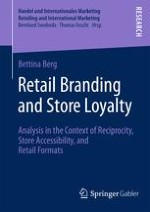Marketers and retailers have to understand how to manage different consumer perception levels of retail brands, which have a major determining role on store loyalty across different complex contexts. Addressing these issues, Bettina Berg analyzes first whether corporate reputation and retail store equity have a reciprocal relationship in determining store loyalty. Second, she evaluates whether retail brand equity or store accessibility provides a greater contribution to store loyalty across different local competitive situations. Third, she investigates whether perceptions of format specific core attributes differ in their impact on the brand building process in saturated and emerging markets.
